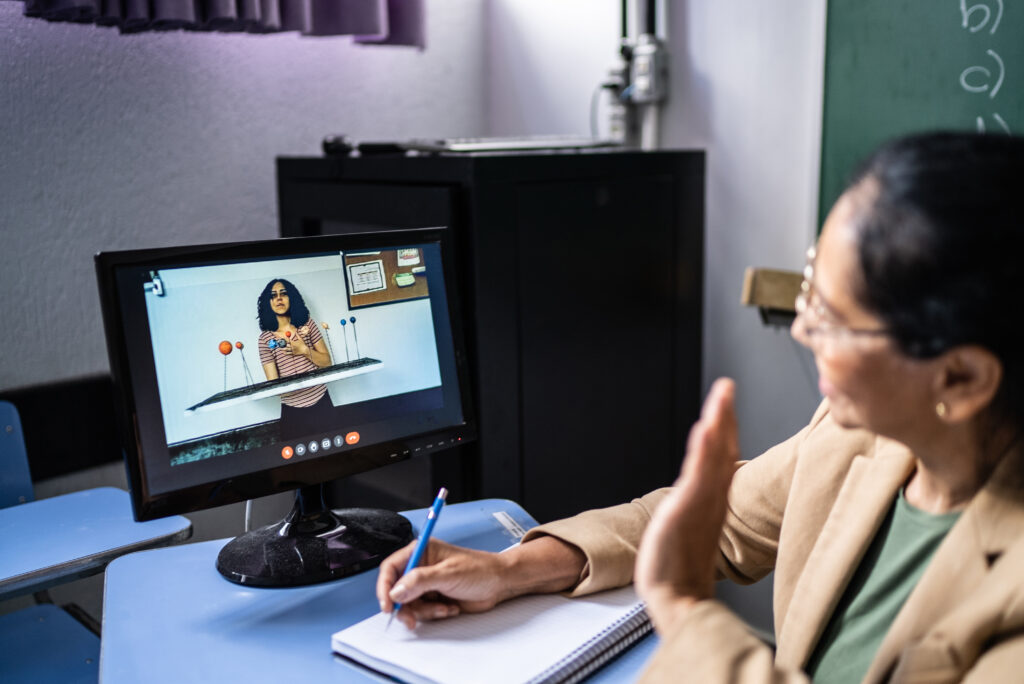In today’s fast-paced world, learning is no longer limited to a traditional classroom setting. With the rise of technology, distance learning has become increasingly popular, allowing individuals to access education anytime, anywhere. One of the most significant trends in distance learning is asynchronous learning, which has gained significant popularity in recent years. In this blog post, we’ll explore what asynchronous learning is, its benefits, and how it differs from synchronous learning. We’ll also provide some tips on how Prezi can help you to practice it successfully.

What is asynchronous learning?
Asynchronous learning is a form of distance studying where students can approach lessons and assignments at their own convenience. This method of learning is great for people with other commitments, like work or family responsibilities, because they’re able to study at any time of the day.
A study published by the Information Systems Education Journal found that although students in asynchronous environments have less real-time interaction, their learning outcomes weren’t much different from those of synchronous learners.
What is synchronous and asynchronous learning?
Synchronous and asynchronous learning both prove to be efficient modes of participating in distance education, but the two modes differ slightly. With synchronous learning, interaction happens in real time- where students and teachers come together virtually on platforms like Zoom or Teams. In contrast, asynchronous learning allows access to study material and completing assignments at a time that best suits the student.
A meta-analysis published by MDPI found synchronous learning to bring about higher engagement because of student-teacher interaction and real-time feedback. On the flip side, asynchronous learning has higher flexibility, so it can be more useful for those who’re trying to balance work or family.

Synchronous learning
Benefits of synchronous learning
Synchronous learning offers several significant benefits, particularly for students who thrive in structured, interactive environments. Here’s a closer look at the advantages:
Real-time interaction
Students can ask questions and receive immediate feedback from instructors, which helps clarify concepts on the spot. This interaction leads to dynamic, engaging sessions where students can dive deeper into topics during discussions or debates.

Structured learning environment
Scheduled times help students stay organized because they can plan their days and set certain times for specific activities. For instance, a student who’s working part-time and going to school can use class time as a structure for blocking out specific study times.
Collaborative learning
Another advantage of synchronous learning is that it helps in real-time collaboration, which can be useful for students working on group projects or team-based learning. For instance, in a break out-room feature, while using Microsoft Teams or Zoom, students can work together on group assignments.
Immediate feedback
Misunderstandings can be righted during the class, so when students leave, they leave with accurate knowledge. For example, in an online coding class, students may have live code reviews with their teachers, so they can immediately address the error instead of struggling on their own.

Social interaction
Human interaction helps create a sense of community, which can combat feelings of isolation that some online learners experience. For example, a study group formed through live chat during a synchronous lecture can continue outside of class, fostering relationships that can last throughout the course.
Challenges of synchronous learning
Despite its advantages, synchronous learning presents some challenges:
Time constraints
It can be hard for students with work or family obligations to follow a very strict schedule. For instance, someone working night shifts may find it difficult to participate in a live lecture at 8 am, making synchronous learning impractical for some.
Technology dependence
One of the major drawbacks to synchronous learning is that it depends on continuous internet access, if attending online lectures, which may be difficult for students from rural areas or locations without strong connectivity. For example, a student with poor Wi-Fi might keep getting disconnected during the live lecture, missing important portions of the lesson. This would obviously set them back in comparison to their peers.

Limited flexibility
If a student misses a live session, they may miss critical information or class discussions. Although some sessions are recorded, the experience of interacting in real time can’t always be replicated. For example, in a live debate or group discussion, missing the session can mean missing out on key insights and peer interaction.
Increased pressure
Real-time participation can cause anxiety for some students who prefer to process information before responding. Such as a student who struggles with public speaking may feel uncomfortable answering questions during a live session, leading to reduced participation.
Asynchronous learning
Benefits of asynchronous learning
Asynchronous learning offers a host of advantages, particularly for students who need flexibility. Let’s break down the key benefits:
Flexibility
What makes asynchronous learning so appealing is convenience because students can work at their own pace. It also opens doors for people in different time zones: who without asynchronous learning, might not have a chance to study specific courses at all.

Self-paced learning
Another advantage is that students are able to spend more time on difficult material while breezing quickly through content that’s easy- making the learning experience more personalized. For instance, a learner who’s having difficulties with a concept in a Physics course can have the video lectures replayed, pause them for notes, or slow them down for better understanding.
Reduced pressure
Asynchronous learning minimizes stress related to the pace of the class and helps ensure that students can learn without the associated pressure of real-time performance. For instance, a student experiencing social anxiety might prefer asynchronous discussions, allowing them time to muse over their thoughts before participating in a forum.

Accessibility
This study method can also be of great help to students with different learning styles or students with disabilities. For example, a pre-recorded video with closed captions may be useful for a hearing-impaired learner, and studying in smaller portions without skipping any content may be useful for a learner with attention issues.
Autonomy and time management
Learners develop strong time management skills since they have to plan their study schedules themselves. For example, a student balancing an internship with schoolwork can use asynchronous learning to study during weekends or evenings, tailoring their study time around work hours.
Challenges of asynchronous learning
Asynchronous learning, while flexible, also can come with some challenges. In order to answer the question “What is asynchronous learning?” it’s important to look at some of the challenges of this learning method:
Time management
Without set class times, students have to manage their own schedules, which may become a burden of procrastination or getting behind for those who lack discipline. For instance, a student with poor organizational skills may put off watching the lectures until the last minute.
Lack of immediate feedback
Waiting for feedback from teachers can slow down the learning process for asynchronous students. For example, a student may be troubled with a question in calculus, but it could take a day or more to have their teacher give feedback, making it quite challenging to understand the concept in real time.

Feeling of isolation
It can be uninspiring for students if their learning experience lacks dynamism due to the absence of real-time interaction with instructors and fellow students.
Motivation and accountability
Some students might experience a lack of motivation if there’s no schedule set or no immediate deadlines. For example, someone who does well with external deadlines might find it a challenge to stay motivated if there are no regular live sessions to keep them accountable.
Choosing between asynchronous and synchronous learning
Making the choice between asynchronous and synchronous learning all depends on which method better suits your learning style. Do you learn better with structure and face-to-face meetings? Or do you prefer to create your own study schedule that fits around your other commitments? While both methods offer their own advantages, asynchronous learning stands out for those who need flexibility and prefer independent learning.

How to practice asynchronous learning successfully
Asynchronous learning requires students to be self-motivated, disciplined, and organized. To practice asynchronous learning successfully, here are some tips and tools to keep in mind:
Develop a study plan
Creating a study plan can help students stay organized and on track with their learning. A study plan should include a schedule of when to study, what topics to cover, and deadlines for assignments or exams. Without a study plan, it can be difficult to prioritize tasks and manage your time effectively.
To create a visually appealing and organized study schedule, use infographic, poster, or other templates available in Prezi. You can either choose from the selection of templates in the gallery or simply create a study schedule from scratch. Afterward, you can print it out and put it in a visible place for you or have a digital version available to you anytime. Here’s an example of a study plan you can create using Prezi:
Set goals
Setting clear goals can help students stay motivated and focused on what they want to achieve. Students should set both short-term and long-term goals for their learning, such as completing a specific assignment or mastering a particular topic. One helpful strategy is to write down a list of your goals and regularly review and update it as you make progress. This not only allows you to keep track of your accomplishments but also provides a sense of satisfaction and boosts your confidence as you tick off each goal.
And having your goals visualized right in front of you will make you more motivated and organized in achieving them. Use a Prezi template visualized in the video below to illustrate your goals.
Communicate with instructors and peers
While asynchronous learning may not involve real-time interactions, it’s still important for students to communicate with their instructors and peers. Students can use email, discussion boards, or other communication tools to ask questions, seek clarification, and collaborate with others. Instructors can also provide valuable feedback on your assignments and offer guidance on how to improve your work, while staying connected with your peers can help to foster a sense of community and support.
If you choose to check in with your instructor or students using a video conferencing tool, make sure to make the meeting even more productive and engaging using Prezi Video, where you can easily showcase your content right next to you on-screen. Or you can choose to record a video of yourself and send it to your instructor or students, where you present your visual material or simply share an important message. Staying connected, while keeping that face-to-face interaction will create a much more engaging learning and teaching experience. See what you can do with Prezi Video and check out the first of the Prezi Education Team’s 7 Tips for Engaging, Effective Instructional Videos featuring Paul Teske, a teacher in residence at Prezi.
Plus, you can also share your Prezi presentation with teachers or students and let them go through the content at their own pace. This is also a great way to stay connected and present content and feedback to each other. You can share a presentation like in the example below, where others can zoom in and out of topics they’re more interested in and view it in whatever order makes sense for them.
Take advantage of available resources
Asynchronous learning often provides students with access to a variety of resources, such as online textbooks, videos, and other multimedia materials. Students should take advantage of these resources to deepen their understanding of course material and enhance their learning experience.
As mentioned, with Prezi you can easily present and share your findings, learnings, and course content asynchronously. You can either choose to share a presentation, a video recording of you presenting your content right next to you on-screen, or create and share other learning materials, like infographics, reports, dashboards, and more. Discover everything that Prezi can offer to enhance your asynchronous learning experience and begin a more engaging learning chapter.
Stay motivated and focused
In conclusion, asynchronous learning offers many benefits for students, including flexibility and convenience. By being self-motivated, disciplined, and organized, students can successfully navigate this learning format and achieve their academic goals. However, it’s important to note that asynchronous learning requires a high degree of personal responsibility and accountability, and students must be willing to put in the effort to stay engaged and connected with the learning community. Additionally, synchronous learning can provide opportunities for students to interact with their peers and instructors in real-time, facilitating immediate feedback and promoting a sense of community and collaboration. However, it may not be as flexible as asynchronous learning and can require strict adherence to a schedule.

If you opt for asynchronous learning, you can elevate your experience using Prezi. With Prezi, students can create visually engaging presentations that incorporate multimedia elements such as images, videos, and audio. This can enhance the learning experience by capturing students’ attention and making the content more memorable. Additionally, Prezi offers collaboration features that enable students to work together on presentations, even if they are not physically present in the same location. This fosters collaboration and encourages peer-to-peer learning, which is beneficial in asynchronous learning environments where direct interaction with classmates may be limited.
Moreover, Prezi’s cloud-based nature allows students to access and present their presentations from any device with an internet connection. This flexibility is particularly advantageous for asynchronous learners who may have varying schedules and need to access their materials at different times and locations.
